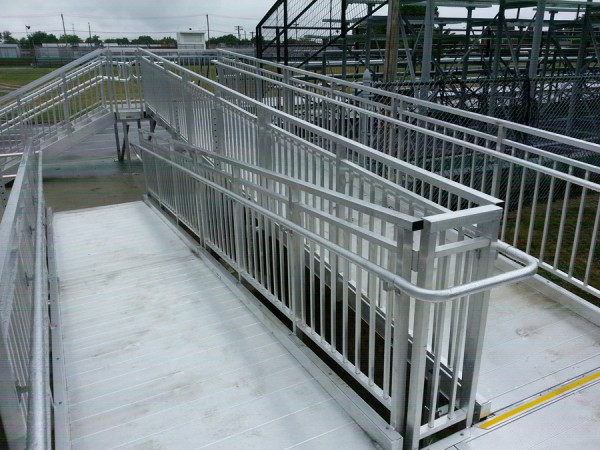One of the hardest parts of living with a disability is not being able to get where you want to go at the drop of a hat. As someone who has a physical disability and uses a wheelchair, I can tell you how a simple trip across town can turn into an accessibility nightmare. With the 1990 Americans with Disabilities Act, there have been vast improvements towards making public buildings accessible. However, try going between a big city and a small town. You will see a difference.
I grew up in a small town outside of Toledo, Ohio. While many of the newest buildings in this town were accessible, not all of them had been modified. For example, I was mainstreamed into the local school district. Our district had three elementary schools that merged into one in the fifth grade. I had to be shipped from the closest elementary school in my town to another elementary school in the district (for kindergarten through fourth grade) because my elementary school had steps. In Junior High, I faced the same problem. I ended up having all my classes in the accessible High School (which was next door to the Junior High) instead.
Disability Issues we Face Every Day
Depending on the disability, accessibility issues may be different for everyone. While steps are almost always a problem for a person with a physical disability (though it is true some have adapted to climbing with assistive devices) the size of the doorway in buildings and homes is going to matter more to a person in a wheelchair than to a person who can walk with braces and crutches.
In an ideal world, every building and residential property would have:
- No steps
- Wider Doorways
- Automatic Door Openers
- Lower Counter tops
- Lower Shelves
- Elevators where necessary
- Ramps with less than 15-degree angles
- Easy to reach appliances
- Hoyer lifts where necessary
- Large Bathrooms with Roll-in Showers
- Grab Bars
Unfortunately, this dream is not yet a reality.
Able-Bodied World View
The world has an able-bodied view. It is made for able-bodied individuals, so finding an accessible home is a task for those of us with physical disabilities. Going shopping is a task. Getting in public buildings, though they are supposed to be accessible, can be a task.
When I went to Bowling Green State University, I complained to the city of Bowling Green about their lack of sidewalks. I got the media involved in my ongoing dispute with the BGSU accessibility office. I had issues with the university spending hundreds of thousands of dollars to put an elevator into Falcon Stadium for alumni when their campus needed a serious accessibility makeover.
At the time of my enrollment in the university, these were the main problems I found:
- Many buildings lacked automatic doors, so I had to shimmy them open from my chair.
- The ramp at the library was so steep and twisted, I was nervous every time I went down it.
- The dorms were hard to get into. I had to have help getting my key card into the high slot to get into my room.
- Getting food could be a task because some of the counters were high.
- The stages (I studied acting at BGSU) all had steps to access them, minus a small acting space upstairs in one building.
- Some elevator buttons were so high they were level with the hand of my 6 foot tall brother.
- The sidewalks on campus were bumpy and some of them had huge cracks I had to avoid.
- The town of Bowling Green did not have many sidewalks.
- Many old buildings were hard to navigate and had elevators that broke down constantly. Do not ask me how many times I was stuck upstairs after class, downstairs so I could not get to class, or in the elevators themselves.
I have not been back to the BGSU campus since 2000 when I vowed to find a college that was more accessible. After a year, the fighting became too much to handle while balancing classes and personal issues in my life.
When I attended BGSU, I would often drive down the side of the busy Bowling Green roads into town in my wheelchair. Some of the buildings were accessible, but most of them were old.
An excellent example of the lack of accessibility is as follows. All my friends went to one particular club that was up a narrow flight of stairs. I had always wanted to go, but the owner was very rude about the fact that his club was not accessible. It would have cost money he did not have — even though the ADA clearly states any building or business offering a service to the public must be made accessible. He got around this because his building was built before 1990 – the one exception to the ADA, which has allowed many businesses to remain inaccessible.
I dropped these issues eventually because some battles are just too big for one person to fight. I had other things to focus on. I had caused enough of a ruckus and people were not very happy with me, as it was. Had it not been for personal issues I doubt I would have given up so easily. In truth, the battle should have continued until every building was made accessible and that is one battle I regret letting go unfinished.
The Quest for Accessibility
I ended up at Wright State University in Dayton, Ohio. It is amazing what a difference a three-hour drive can make.
The pluses of WSU were:
- Every building I went to, including the dorms, had automatic doors. Additionally, automatic doors were installed on the personal entries to disabled dorms as well as the disabled individual’s own room/apartment.
- The campus, though hilly, was a smooth ride for a wheelchair.
- Disabled dorms had roll-in showers.
- Disabled parking spaces were in front of every building
- The buildings on campus (minus dorms) were accessible by underground tunnels so winter snow could be avoided
- The sidewalks around campus led to a nearby Meijer (think of a Wal-Mart style store), numerous food places including McDonalds, Wendy’s, and Big Boy, and a Credit Union.
- There WAS a personal assistance program for those who live on campus
- Every building had elevators. An elevator breakdown was often handled quickly.
- The campus dining services employees were more than willing to assist you in getting things to eat and drink if you needed it.
- Note taking, test taking, and tutoring services were available. Any accommodations necessary for classes were made through the office of disability services.
- Many disabled people went to WSU so you had friends you could talk to who understood your struggles with accessibility.
- An overall “disability-friendly” attitude was present on campus.
- Disabled sports at both the competitive and fun level were available.
- Bathroom assistance was available on campus during the day in case you needed to run to the bathroom between classes.
- Hoyer lifts were present in the on campus PA station bathrooms.
- The on-campus swimming pool was accessible.
- The on-campus workout center had more than one piece of accessible gym equipment.
- The campus shuttle was accessible – though this is not without its problems.
- The bus to downtown Dayton had a lift, making the city of Dayton extremely accessible to on-campus students.
Why can’t all schools be this way? As always, there was and still is room for improvement, but compared to BGSU, WSU was a breath of fresh air. It was truly the first time I felt accepted. Only one other city I have been to, to date, has had such a welcoming vibe in terms of accessibility, and that is Manhattan. Considering all the problems New York has with accessibility, that is saying a lot about the rest of the United States.
Achieving Accessibility
When I went into a wheelchair at 16, and even before then, I was seldom invited over to my peers’ houses. In fact, one of the only places I remember going is to my friend’s house who was also in a wheelchair. It was a good thing his house had a ramp!
A lack of accessibility is something able-bodied people take for granted and you should not do this. You never know if you will be the next person in a wheelchair. Once it happens, it turns your life upside down and suddenly you become the next activist wanting to make the world accessible.
The time to act and get the ball rolling towards making the world more accessible is now. The key to this is becoming conscious of your surroundings and familiarizing yourself with the need for change.
I challenge all of the able-bodied individuals who read this, to the accessibility test. For a week, I want you to write down everything in your home, town, and workplace that you think could be improved. If you notice public buildings with no ramps or elevators, write it down. If your bathroom is so narrow you can barely get into it standing up, write it down. Write down anything you can think of that seems to need improvement.
At the end of the week, examine your list. I bet you will be surprised at how inaccessible the world really is. If you feel compelled to change the way the world develops businesses and real estate properties, send an email to your mayor, governor, city council members, and any other government officials. Let them know what buildings are still not accessible in your town. Make sure you stress how unacceptable this is.
Email real estate developers and tell them you support the development of disability-friendly homes. Let them know that it is their duty as builders of housing for the public to make their homes accessible to everyone.
Together we can make the world more disability-friendly. Together we can ensure that any person in a wheelchair has the access they need to doctors offices, dentist offices, hospitals, homes, and supermarkets. Without the support of the able-bodied population, we are fighting a losing battle. So, please take the time to support our cause just in case a loved one of yours is in our shoes and it is too late to make it easier in their and your lives.
Note: This article was first published on Literary Illusions’ website in August of 2006. Not much has changed since it was written. These issues are still pertinent, today.



Comments